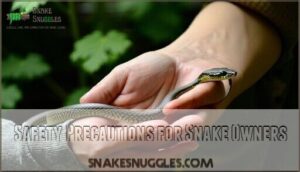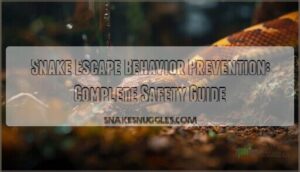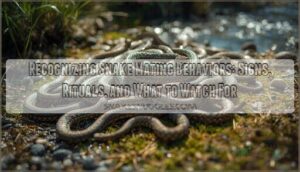This site is supported by our readers. We may earn a commission, at no cost to you, if you purchase through links.

Most bites happen when your snake feels threatened, stressed, hungry, or mishandled. Ball pythons and corn snakes are generally docile, while species like king snakes can be more defensive.
Poor environmental conditions, sudden movements, and feeding mistakes are common triggers. Non-venomous pet snake bites are typically minor injuries that heal quickly with proper care.
The key is understanding your snake’s body language—coiling, hissing, and rapid movements are clear warning signs. With proper handling techniques and a well-maintained habitat, you can substantially reduce bite risks while building trust with your scaly companion.
Table Of Contents
- Key Takeaways
- Risks of Pet Snake Bites
- Do Pet Snakes Bite Their Owners
- Preventing Snake Bites
- Signs a Snake is About to Bite
- What to Do if a Pet Snake Bites
- Snake Bite Treatment and Severity
- Caring for a Snake After a Bite
- Safety Precautions for Snake Owners
- Long-Term Risks and Consequences
- Frequently Asked Questions (FAQs)
- Conclusion
Key Takeaways
- Your snake isn’t being malicious when it bites – they’re responding to stress, hunger, or feeling threatened, so understanding their triggers helps you prevent defensive reactions.
- Watch for clear warning signs before strikes occur – hissing, S-shaped coiling, rapid tongue flicking, and tense body posture give you time to back away and avoid bites.
- Most pet snake bites are minor injuries that heal quickly – non-venomous species like ball pythons and corn snakes cause puncture wounds that need basic wound care and infection monitoring.
- You can drastically reduce bite risk through proper handling and habitat care – support their body weight, move slowly, maintain proper temperatures and humidity, and avoid handling during shedding or feeding times.
Risks of Pet Snake Bites
You’ll likely encounter a snake bite at some point as a pet owner, since most snakes will bite at least once during their lifetime when startled or stressed.
Understanding the specific risks helps you prepare for safe handling and know what triggers defensive behavior in your snake.
Reasons Why Pet Snakes Bite
Pet snakes typically bite when they feel threatened, mistake your hand for food, or experience stress from improper handling.
Most snake bites happen when your pet feels cornered, hungry, or stressed from poor handling
Understanding these bite triggers helps prevent accidents through better pet safety practices.
Common reasons snakes bite:
- Defensive response when startled or feeling cornered
- Hunger-driven mistakes during feeding time
- Stress from poor environmental conditions or illness
- Territorial behavior when their space feels invaded
Proper handling techniques and recognizing snake behavior patterns substantially reduce bite risk while keeping both you and your snake comfortable.
Common Snake Species That Bite
Ball pythons and corn snakes top the list of docile pet species, but even these gentle giants can deliver surprising nips.
King snakes show more curious, nippy behavior when startled, while garter snakes remain generally calm.
Aggressive breeds like reticulated pythons and black racer snakes pose higher bite risks.
Most non venomous snakes bite defensively rather than aggressively, making pet safety about understanding each snake species’ unique biting patterns and snake behavior triggers.
Factors Increasing The Risk of Bites
Understanding which factors increase pet snake bites helps you stay safe.
Several conditions can trigger snake aggression and heighten snake bite risks:
- Hunger Stress – An empty stomach makes your snake mistake your hand for prey
- Shedding Period – Irritability peaks when their skin’s coming off, making them extra defensive
- Environmental Factors – Cramped, dirty enclosures create chronic stress that builds aggression
- Handling Errors – Sudden movements or grabbing too quickly startles even calm snakes
Snake temperament varies by species, but aggressive behavior often stems from these preventable triggers rather than natural nastiness.
Recognizing these snake bite prevention factors keeps both you and your pet comfortable. Mastering proper pet snake handling is essential for a safe and enjoyable experience with your pet.
Do Pet Snakes Bite Their Owners
Pet snakes can and do bite their owners, though it happens less often than many people expect.
Most bites occur when snakes feel threatened, mistake your hand for food, or experience stress from improper handling.
Understanding Snake Behavior
Snakes don’t bite out of malice—they’re responding to their environment.
Snake behavior follows predictable patterns: stress triggers defensive postures, hunger increases bite risk, and improper animal handling leads to startled reactions.
Reptile psychology shows these creatures prefer routine and minimal disturbance.
Watch for coiling, hissing, or rapid movements—clear signals your snake feels threatened and needs space.
Identifying Aggressive Behavior
Recognizing aggressive behavior patterns helps prevent bites before they happen.
When your snake displays stress factors, it’s telegraphing its intentions through specific bite warning signals.
Watch for these aggressive signs:
- Hissing and open-mouth displays – Over 75% of snake bites follow hissing, your clearest warning signal.
- Rapid tongue flicking – Flicking rates of 30-40 times per minute indicate heightened stress and potential aggression.
- Coiled defensive snake posture – An elevated head with tense body positioning precedes 90% of aggressive episodes.
Recognizing Body Language
When your snake’s body language shifts from relaxed to tense, you’re seeing clear warning signs.
Watch for defensive head position with neck pulled back, tight coiling behavior that forms an S-curve, and rapid tail signs like twitching.
A stiff snake posture paired with direct eye contact signals stress.
These aggressive behavior cues help you read your snake mood and adjust handling techniques accordingly.
Preventing Snake Bites
You can substantially reduce your snake’s likelihood of biting by mastering proper handling techniques and creating an ideal environment.
Most bites happen when snakes feel threatened, stressed, or mistake your hand for food—all preventable situations with the right approach.
Proper Snake Handling Techniques
Proper handling starts with supporting your snake’s entire body using a gentle touch and slow movement. A calm approach prevents startle responses that trigger defensive biting.
Support the head and midsection while allowing natural snake wrapping around your arm. Handling tools like hooks work best for larger species, while smaller snakes respond well to direct contact using proper handling techniques.
For safe handling, this is necessary to use proper snake hook devices handling snake hooks to minimize risks.
Environment and Housing Considerations
Beyond proper handling techniques, your snake’s home environment directly impacts bite risk. A well-designed habitat keeps stress levels low and reduces defensive behaviors.
Key housing elements that prevent bites:
- Cage size – Provide adequate space for natural movement and stretching
- Temperature regulation – Maintain proper heat gradients to avoid thermal stress
- Humidity control – Keep moisture levels within species-appropriate ranges
- Housing safety – Include secure hiding spots and escape-proof enclosures
Your snake enclosure should feel like a safe haven, not a prison. When snakes feel secure in their snake habitat, they’re less likely to strike defensively during handling or maintenance. Properly designed snake enclosures play a vital role in maintaining a healthy environment.
Feeding and Nutrition Guidelines
Nutrition plays a major role in your snake’s temperament and bite risk. Well-fed snakes are calmer and less likely to mistake your hand for their next meal. Poor snake nutrition creates stressed, defensive reptiles that snap at anything moving.
Follow these meal planning guidelines:
- Establish a consistent feeding schedule based on your snake’s age and species requirements
- Choose appropriate snake food sizes – prey should be roughly the same width as your snake’s thickest point
- Meet specific nutrient requirements through varied prey types or veterinarian-recommended supplements
- Monitor your pet’s dietary needs by tracking weight and adjusting portions accordingly
Proper snake feeding prevents hunger-induced aggression while supporting overall snake health and reptile care success.
Signs a Snake is About to Bite
Recognizing when your snake is about to bite can prevent injuries and help you understand your pet’s stress signals.
Watch for specific body language cues, behavioral changes, and environmental factors that trigger defensive responses in snakes, which can be crucial in preventing bites and ensuring a safe interaction with your pet.
Body Language Indicators
Reading body language signs can help you spot trouble before it starts. Watch for defensive snake posture—when your snake coils into an S-shape with its head retracted, it’s preparing to strike.
Raised head position and arched upper body signal heightened alertness. Hissing combined with body inflation serves as a warning to back off.
Understanding snake behavior through stress signal recognition is essential for safe handling.
| Body Language | Meaning |
|---|---|
| S-shape coiling with head retracted | Strike preparation |
| Rapid tongue flicking | Environmental assessment |
| Open mouth display | Visual warning |
Eye contact becomes intense and unwavering when snakes focus on threats. Tail vibrations warn potential dangers to retreat.
These scaled patterns of behavior help you recognize when your pet needs space during snake handling sessions.
Changes in Behavior
When snakes experience snake stress, you’ll notice distinct behavioral shifts that signal potential bite risk.
These changes often stem from environmental factors, feeding patterns disruptions, or inadequate socialization techniques affecting their temperament.
Recognizing snake stress signs is essential for preventing bites.
- Shedding periods make snakes irritable and defensive, showing increased snake lethargy
- Illness symptoms alter normal snake behavior patterns dramatically
- Hunger spikes cause frantic movements, mistaking hands for prey
- Breeding seasons heighten aggression through hormonal snake stress signs
Environmental Triggers
Several environmental factors can trigger defensive responses in your snake.
Temperature control issues, sudden humidity levels changes, or cramped cage size create stress that increases bite risk.
Bright lighting effects and disturbances during feeding environments particularly agitate snakes.
Monitor these snake bite triggers closely—like unexpected noises or vibrations—as they signal snake stress signs.
Maintaining stable snake environment considerations through consistent minimal disturbances helps prevent these snake bite prevention tips situations, ensuring better snake safety overall.
What to Do if a Pet Snake Bites
Even the gentlest pet snake can bite when startled, hungry, or stressed, turning a routine interaction into a medical situation that requires immediate attention.
Knowing how to respond quickly and properly can prevent serious complications like infection while ensuring both you and your snake recover safely.
Immediate Response and First Aid
When a snake bite occurs, swift action can make all the difference in preventing complications. Stay calm and assess the situation immediately.
Stay calm and act fast – quick response prevents serious complications
Bite Assessment starts with identifying puncture wounds, lacerations, or bleeding patterns. Wound Cleaning becomes your first priority—flush the area with warm water and antiseptic soap for several minutes to remove bacteria and debris.
Follow these First Aid steps:
- Keep the person calm and still to prevent panic
- Apply direct pressure with clean cloth to control bleeding
- Use cool compress to reduce swelling and inflammation
- Keep the bitten area below heart level when possible
- Avoid tourniquets, cutting, or sucking the wound
Emergency Response requires Medical Attention for deep punctures, persistent bleeding, or signs of infection. Even minor snake bite symptoms warrant professional evaluation due to bacterial infection risks, including salmonella transmission from snake mouths. It’s vital to understand snake bite risks to provide proper care.
Preparing for Veterinary Treatment
When facing a snake bite emergency, your quick preparation can make all the difference.
Note the snake’s species and bite location—this snake identification helps your veterinarian assess bite assessment needs and determine appropriate snake bite treatment.
Contact your vet immediately for medical guidance on emergency response protocols.
Gather your emergency kit and prepare for safe transport, ensuring you can provide complete bite assessment details and snake bite symptoms to facilitate proper veterinary care and wound care decisions.
Preventing Infection
After addressing immediate medical needs, infection prevention becomes your top priority. Snake mouths harbor various bacteria that can cause serious complications if left untreated.
Essential infection control steps:
- Wound cleaning – Flush with soap and water for 2-3 minutes, removing all debris
- Antibiotic use – Apply topical antibiotics as directed by your healthcare provider
- Hygiene practices – Keep hands sanitized when changing dressings
- Bacterial prevention – Watch for redness, swelling, or unusual discharge
- Salmonella infection monitoring – Report fever, nausea, or stomach pain immediately
Proper snake bite wound care prevents minor injuries from becoming major problems. Change bandages daily and keep the area dry between cleanings.
Ball Pythons
When dealing with ball python bites, remember that these gentle giants rarely strike without good reason.
Ball pythons rank among the most docile pet snakes, making them excellent choices for beginners focused on proper Python Handling and Ball Python Care.
Here’s your action plan for ball python bites:
- Stay calm – Your composure helps reduce the snake’s stress levels
- Clean thoroughly – Wash the bite area with soap and water immediately
- Monitor closely – Watch for unusual Ball Python Behavior or snake bite symptoms
Most ball python bites result from startling during Python Feeding time or inadequate Snake Habitat conditions.
These pet snake bites typically cause minimal damage, but proper snake bite care prevents infection and maintains your python’s trust.
Reticulated Pythons
Reticulated pythons pack serious size and aggressive traits that demand respect.
These giants can deliver powerful bites when stressed or threatened, making proper python behavior understanding essential for snake owners.
Reticulated care requires meeting their substantial space and python feeding needs.
If bitten, remain calm and clean thoroughly.
Their impressive strength means snake handling demands extra caution and experience with pet reptiles.
Black Racer Snakes
Black racer snakes pack more attitude than other pet species, making bites more likely when they feel cornered or threatened.
If your black racer strikes, here’s your action plan:
- Clean the wound immediately with soap and warm water
- Stay calm – panicking won’t help you or your snake
- Check their habitat for temperature or stress triggers
- Call your vet if swelling or irritation develops
Understanding black racer snake behavior helps prevent future incidents through proper snake handling techniques.
Snake Bite Treatment and Severity
Most pet snake bites cause minor symptoms like puncture wounds and mild bleeding, but some species can inflict more serious injuries.
You’ll need to assess the severity quickly and determine if medical attention is necessary based on the bite’s depth, bleeding, and your snake’s species.
Minor and Severe Symptoms
Snake bite reactions range from mild irritation to serious medical emergencies. Most snake bites from pets cause minor wound care needs, but you’ll want to watch for escalating symptoms.
| Minor Symptoms | Severe Symptoms |
|---|---|
| Slight swelling, redness | Breathing difficulties, nausea |
| Minor puncture marks | Intense pain management needs |
| Light bleeding | Infection signs, fever |
Snake bite symptoms develop quickly, so monitor yourself closely after any incident. While snake venom isn’t a concern with most pets, bacterial infections can still occur.
Proper snake bite first aid and snake bite wound care prevent complications. Remember, even your normally docile python might surprise you when startled. It’s also essential to recognize snake health issues to provide the best care for your pet.
Antivenom Treatment
While minor bites need basic wound care, antivenom becomes your lifeline for venomous snake encounters.
This medical intervention neutralizes circulating toxins, but timing matters—effectiveness drops substantially after four hours.
Antivenom dosage depends on symptom severity, not your size. Emergency response teams administer it intravenously, often requiring multiple doses.
Snake bite kits won’t help here; professional venom removal through antivenom is essential.
Expect possible allergic reactions and high costs.
Don’t hesitate—snake bite treatment saves lives when administered promptly by medical professionals.
Clinical Signs in Different Species
Different snake species show distinct bite symptoms you’ll want to recognize.
Ball pythons typically cause minor puncture wounds with minimal swelling – think pinprick sensations.
Reticulated pythons deliver more forceful bites, often resulting in deeper wounds, bruising, and moderate swelling.
Black racer snake bites, while non-venomous, can create jagged lacerations that heal slowly due to their aggressive striking behavior and sharp teeth.
Caring for a Snake After a Bite
After your snake bites, you’ll need to create a calm, secure environment while closely watching for changes in behavior or health.
This period requires careful observation to identify any underlying stress factors or medical issues that may have contributed to the bite incident, and it is crucial for determining the best course of action to ensure the snake’s and your well-being.
Providing a Safe Environment
After treatment, your snake needs proper snake enclosure setup to recover safely.
Focus on temperature management and humidity control – keep temperatures stable within species-specific ranges and maintain proper moisture levels.
Choose appropriate substrate and guarantee adequate ventilation for superior environment design.
These snake handling techniques include minimizing disturbances while monitoring your pet’s recovery progress.
Monitoring Behavior and Health
After your snake bites, you’ll want to keep tabs on subtle changes that might signal trouble ahead. Watch for shifts in appetite, unusual hiding patterns, or changes in movement that could indicate stress or health issues requiring attention.
Here’s what to monitor during your Snake Health Checks:
- Feeding responses – Note any reluctance to eat or changes in feeding behavior that might suggest underlying stress
- Shedding cycles – Track when your snake sheds and watch for incomplete sheds or extended blue phases
- Activity patterns – Monitor whether your snake’s daily routines change, including basking and hiding habits
- Physical appearance – Check for snake bite symptoms like swelling, discharge, or unusual posturing during routine observations
- Environmental interaction – Observe how your snake responds to Habitat Maintenance activities and temperature changes
Understanding snake body language helps you catch problems early. Changes in Pet Snake Nutrition needs or Behavioral Signs of distress often appear before serious health issues develop, making regular monitoring essential for effective snake bite prevention.
Addressing Underlying Issues
After monitoring your snake’s behavior, you’ll want to address root causes behind the bite.
Snake stress from improper environmental factors often triggers defensive responses. Check temperature, humidity, and enclosure size – cramped or uncomfortable conditions increase aggression.
Review your handling techniques and feeding schedule. Poor owner preparation and inconsistent care create anxiety.
Address these underlying issues through proper habitat management and consistent routines for effective bite prevention.
Safety Precautions for Snake Owners
As a responsible snake owner, you’ll need to master essential safety practices that protect both you and your pet.
These precautions become second nature once you understand your snake’s behavior patterns and establish proper handling routines, which involve understanding complete concepts.
Safe Handling Practices
Proper handling tools like hooks and tongs provide essential snake restraint for larger species.
Gentle handling with a calm approach prevents defensive responses. Wash hands before contact to remove food scents that trigger feeding responses. Move slowly and support the snake’s body weight when lifting.
These safety measures and safe handling techniques form the foundation of effective snake bite prevention and responsible pet snake care.
Effective snake handling also involves using the right snake hook tools to minimize risks.
Avoiding Kisses and Close Contact
Beyond safe handling, maintaining safe distance from your pet snake prevents skin infections and other health risks.
Resist the urge for kisses or close facial contact—snake hygiene matters since reptiles naturally carry Salmonella bacteria.
Hand washing after any interaction protects you from potential pathogens.
Keep close proximity minimal during handling sessions for effective snake bite prevention and snake bite safety.
Safe Environment Considerations
Your snake’s home determines its stress level and bite risk.
Secure enclosures prevent escapes while proper cage size allows natural movement.
Establish a temperature gradient from 75-95°F with multiple hiding spots for security.
Maintain constant water access and check latches regularly.
These snake bite safe environment practices create predictable conditions that reduce defensive behaviors and promote calm handling experiences.
Long-Term Risks and Consequences
While most pet snake bites heal without lasting problems, you’ll want to understand the potential long-term consequences that can develop.
These risks range from persistent infections and scarring to psychological impacts that might affect your relationship with your snake.
Infection Risks
Bacterial transmission from snake bites creates serious health risks you shouldn’t ignore.
Up to 57% of non-venomous bites develop infections, with Aeromonas and Pseudomonas leading the charge.
Proper wound care prevents most complications:
- Clean immediately with antiseptic soap and running water
- Apply pressure to control bleeding with sterile gauze
- Monitor closely for swelling, redness, or discharge
- Seek medical attention if systemic infections develop.
Salmonella concerns add another layer of risk, especially with delayed treatment beyond 24 hours.
Physical Harm
Physical consequences from pet snake bites extend beyond initial puncture wounds. Bite injuries can cause localized swelling, bruising, and persistent pain lasting several days.
Even non-venomous species deliver bacteria-laden saliva that complicates healing.
| Injury Type | Severity Level | Recovery Time |
|---|---|---|
| Surface punctures | Mild | 3-5 days |
| Deep lacerations | Moderate | 1-2 weeks |
| Infected wounds | Severe | 2-4 weeks |
| Tissue damage | Variable | Weeks to months |
Snake bite severity depends on species size and bite duration.
Proper wound care and pain management prevent complications, while injury prevention through careful handling remains your best defense against snake bite physical harm.
Emotional Trauma
Beyond physical wounds, emotional scars can linger long after healing.
The psychological impact creates lasting snake bite emotional trauma that affects future interactions with your pet.
Trauma response symptoms include anxiety, avoidance behaviors, and heightened stress around snakes.
Proper stress management techniques and emotional support help process these feelings.
Remember, mental health matters just as much as physical recovery when rebuilding trust.
Frequently Asked Questions (FAQs)
Can a pet snake bite you?
Yes, pet snakes can bite you, though it’s relatively uncommon with proper care.
Most non-venomous species like ball pythons are docile, but they’ll bite if startled, hungry, or stressed during shedding periods.
Do non venomous snakes bite?
Non-venomous snakes can still bite when startled, stressed, or mistaking your hand for food. They’re generally docile creatures, but even gentle species like corn snakes will bite occasionally.
Can a snake bite a tame snake?
Snakes can bite other snakes, including tame ones.
Even well-socialized pet snakes may bite tank mates due to feeding responses, territorial disputes, or stress.
You’ll want to house most snake species separately to prevent injuries from bites.
Do snakes bite unexpectedly?
Like a sleeping dog that suddenly startles, even the most docile pet can surprise you.
Yes, snakes do bite unexpectedly, even when they’re well-cared for and tame.
Startle responses and mistaking your hand for food are common triggers.
Do pythons bite?
Pythons can bite, especially when startled, hungry, or stressed.
Ball pythons rarely bite with proper handling, but reticulated pythons are more aggressive.
You’ll reduce bite risk through calm movements and consistent care.
Are venomous snakes dangerous?
What makes a snake’s fangs a loaded weapon?
Venomous snakes pose serious health risks through potent toxins delivered via specialized bite mechanisms.
You’ll need immediate emergency medical care, as venom can cause tissue damage, organ failure, or death without proper antivenom treatment.
Do snakes bite dogs?
Yes, pet snakes can bite dogs if they feel threatened or cornered.
You should supervise outdoor playtime and keep your snake’s enclosure secure to prevent encounters that could stress both pets.
What if my pet has been bitten by a snake?
When your pet’s been bitten, every second counts like a ticking clock.
Immediately clean the wound with soap and warm water, apply pressure to control bleeding.
Rush to your veterinarian for professional treatment and potential antivenomics.
Can a snake bite kill a dog?
Venomous snake bites can absolutely kill dogs, depending on the species and bite severity. Non-venomous pet snake bites rarely cause death but may lead to infections requiring veterinary care immediately.
Can a dog survive a snake bite?
Time is of the essence when your dog gets bitten by a snake.
Dogs can survive snake bites with immediate veterinary care, though outcomes depend on the snake species and bite severity.
Conclusion
Ironically, while pet snakes don’t bite to hurt you, they’ll still leave their mark when you least expect it.
Understanding why pet snakes bite—stress, hunger, or feeling threatened—helps you prevent these incidents entirely.
Proper handling techniques, recognizing warning signs, and maintaining ideal habitat conditions substantially reduce bite risks.
Remember, your snake’s "aggressive" behavior is simply communication, and with patience and knowledge, you’ll build a trusting relationship where bites become rare exceptions rather than fearful expectations.
- https://www.reddit.com/r/Sneks/comments/6mup2p/people_with_pet_snek_does_pet_snek_bite/
- https://www.youtube.com/watch?v=wEmvWxcTsHQ
- https://www.healthline.com/health/ball-python-bite
- https://thetyedyediguana.com/blog/what-to-do-when-your-pet-snake-bites-you/
- https://www.petmd.com/reptile/care/evr_rp_what-do-if-your-pet-snake-bites-you





















